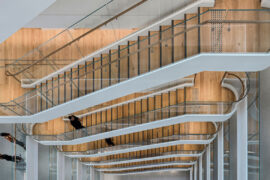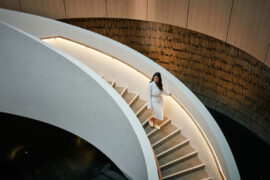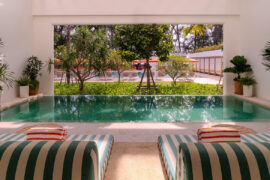Sometimes the most evolved designs are those left incomplete. When conceptualising the new Suncorp headquarters in Sydney, Geyer worked to the idea of ‘designing to 80 per cent’. The result is a radical take on workplace flexibility. While the building caters to its occupants in the present, it comprehensively avoids dictating their needs going into the future.
To state the obvious, design is – at its core – for people. The best commercial designs work on a granular level to ensure that the most idiosyncratic and fine-grain needs of its occupants are anticipated in advance, even before they move into a building. But the glaring disparity between design and the people it works for is that, while people change and adapt, large-scale design – once implemented – often can’t.
In this sense, Geyer’s interior scheme for Suncorp’s new Sydney headquarters is more organic than monolithic. Mark Talbot, studio leader at Geyer, runs through the various conceptual overlays that informed the project, all of which came back to flexibility. For instance, he says, the idea of ‘designing to 80 per cent’ was one of the key aspects of Suncorp’s brief, an idea that was “a ‘wow’ moment” for Geyer; a breath of fresh air from the polished and perfect designs so commonly sought by big corporates.
“Thinking ahead was a really important part of this,” says Talbot. “The space needed to be elastic and fluid; Suncorp knew that, considering how fast technology is changing, everything would need to be transformed, so they didn’t want to make it so that everything was integrated. They needed to be able to undo stuff when they needed to open up more space, or when they needed to enclose space. They wanted stuff to be easily swapped in and out.” Geyer’s response to this was to treat the building as two separate design components to be tackled: “a shell and scenery”.
The ‘shell’ aspect refers to those necessary structural components that frame and map any built project: the walls, the roof, the rooms, and anything that could and should not be easily moved. But the ‘scenery’ is where this project really distinguishes itself. To describe this deep-rooted and pervasive flexibility, Talbot uses the analogy of a theatre set: inside the cocooning shell, all of the components that form Suncorp’s scenery are able to be constantly curated and reinterpreted by occupants. Geyer’s design is such that all Suncorp employees become designers in their own right. “One of the key principles was to completely untether people from where they were working so that they were able to work anywhere,” says Talbot.
As we walk through the building, Geyer designer Lisa Beetson points out all of the components that are there one minute, but might be completely different the next. In smaller conference spaces, we are shown walls that can be completely retracted to merge three adjoining rooms; walking past a large boardroom whose shell of writable whiteboard wall panels are currently configured to accommodate a team of about 20, we are told that these panels can be moved around the overarching metal framework and re-configured into smaller sets of two, three, six or more individual spaces; a demonstration of the furniture around the oce proves that all of it is highly moveable.
“It was very different from other workplaces I’ve worked on, where they don’t like furniture to move; where the furniture just stays in that one spot,” says Beetson. “Where here, it has to be on casters or easily moveable so that [employees] can spread it and move it and curate the space however they want.”
As much as many contemporary workplaces are being designed as ‘agile’ or ‘mobile’ to accommodate a changing workforce, this is only so helpful if workers have no motivation to move around a space. To encourage Suncorp employees to try out the various iterations of workspace across the building levels, Geyer designed four key floors: two ‘community floors’ on levels seven and 15 that can be used for larger gatherings or as an alternative to off-site meetings, and two different layouts of ‘typical’ work floors sandwiched in-between.
The two layouts of these work floors have been dubbed ‘A’ floors, which have a larger range of meeting spaces and drop-down desk arrangements; and ‘B’ (or ‘hub’) floors that have a greater mix of social spaces, as well as larger kitchens. These typologies have been arranged in a BAAB configuration across floors. “The idea is that you’re only one floor away from the other floor type, so it encourages mobility and people making use of other facilities,” explains Beetson.
We recently chatted with Geyer’s new CEO, Wendy Geitz, catch our interview.
–
Want to get more of these stories straight to your inbox? Sign up for our newsletter.
INDESIGN is on instagram
Follow @indesignlive
A searchable and comprehensive guide for specifying leading products and their suppliers
Keep up to date with the latest and greatest from our industry BFF's!

London-based design duo Raw Edges have joined forces with Established & Sons and Tongue & Groove to introduce Wall to Wall – a hand-stained, “living collection” that transforms parquet flooring into a canvas of colour, pattern, and possibility.

A curated exhibition in Frederiksstaden captures the spirit of Australian design

For Aidan Mawhinney, the secret ingredient to Living Edge’s success “comes down to people, product and place.” As the brand celebrates a significant 25-year milestone, it’s that commitment to authentic, sustainable design – and the people behind it all – that continues to anchor its legacy.

From Valmont to GEYER VALMONT, Marcel Zalloua walks us through some of the milestones of what has been a fruitful, busy career in design.

Brad Krauskopf, CEO & Founder of Hub Australia, tells us about Hassell’s design for Hub Australia Martin Place.
The internet never sleeps! Here's the stuff you might have missed

Experience sustainability and luxury in one unforgettable stay! Alba Thermal Springs joins the Sustainability Summit as our exclusive prize partner.

Opening in October 2025, The Standard, Pattaya Na Jomtien brings together ONION, DIN Studio, Studio Lupine and Verena Haller to create a sculptural modernist retreat where art, architecture and coastal culture meet.

Central Station by Woods Bagot in collaboration with John McAslan + Partners has been named one of two joint winners of The Building category at the INDE.Awards 2025. Recognised alongside BVN’s Sirius Redevelopment, the project redefines Sydney’s historic transport hub through a transformative design that connects heritage with the demands of a modern, growing city.